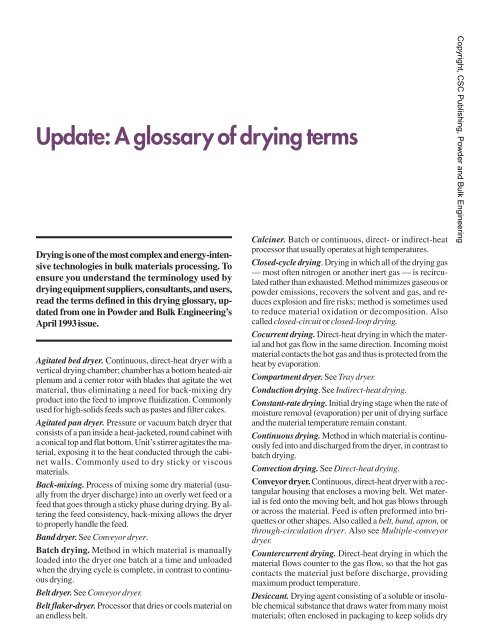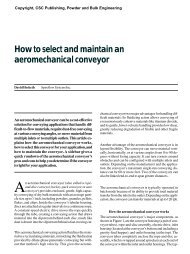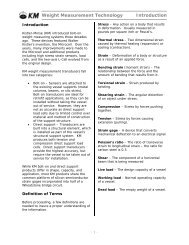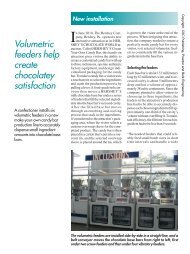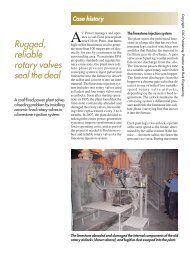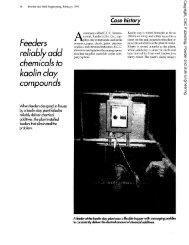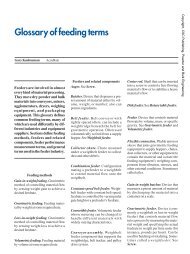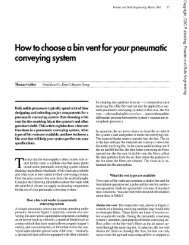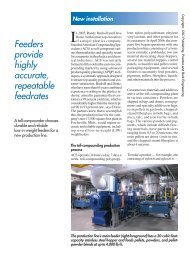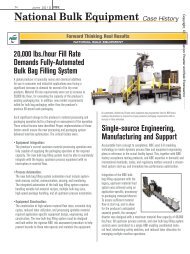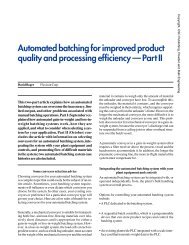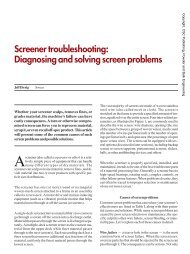Drying Glossary - Powder and Bulk Engineering Magazine
Drying Glossary - Powder and Bulk Engineering Magazine
Drying Glossary - Powder and Bulk Engineering Magazine
- No tags were found...
You also want an ePaper? Increase the reach of your titles
YUMPU automatically turns print PDFs into web optimized ePapers that Google loves.
Update: A glossary of drying terms<strong>Drying</strong>isoneofthemostcomplex<strong>and</strong>energy-intensivetechnologies in bulk materials processing. Toensure you underst<strong>and</strong> the terminology used bydryingequipmentsuppliers,consultants,<strong>and</strong>users,read the terms defined in this drying glossary, updatedfrom one in <strong>Powder</strong> <strong>and</strong> <strong>Bulk</strong> <strong>Engineering</strong>’sApril1993issue.Agitated bed dryer. Continuous, direct-heat dryer with avertical drying chamber; chamber has a bottom heated-airplenum <strong>and</strong> a center rotor with blades that agitate the wetmaterial, thus eliminating a need for back-mixing dryproduct into the feed to improve fluidization. Commonlyused for high-solids feeds such as pastes <strong>and</strong> filter cakes.Agitated pan dryer. Pressure or vacuum batch dryer thatconsists of a pan inside a heat-jacketed, round cabinet witha conical top <strong>and</strong> flat bottom. Unit’s stirrer agitates the material,exposing it to the heat conducted through the cabinetwalls. Commonly used to dry sticky or viscousmaterials.Back-mixing. Process of mixing some dry material (usuallyfrom the dryer discharge) into an overly wet feed or afeed that goes through a sticky phase during drying. By alteringthe feed consistency, back-mixing allows the dryerto properly h<strong>and</strong>le the feed.B<strong>and</strong> dryer. See Conveyor dryer.Batch drying. Method in which material is manuallyloaded into the dryer one batch at a time <strong>and</strong> unloadedwhen the drying cycle is complete, in contrast to continuousdrying.Belt dryer. See Conveyor dryer.Belt flaker-dryer. Processor that dries or cools material onan endless belt.Calciner. Batch or continuous, direct- or indirect-heatprocessor that usually operates at high temperatures.Closed-cycle drying. <strong>Drying</strong> in which all of the drying gas— most often nitrogen or another inert gas — is recirculatedrather than exhausted. Method minimizes gaseous orpowder emissions, recovers the solvent <strong>and</strong> gas, <strong>and</strong> reducesexplosion <strong>and</strong> fire risks; method is sometimes usedto reduce material oxidation or decomposition. Alsocalled closed-circuit or closed-loop drying.Cocurrent drying. Direct-heat drying in which the material<strong>and</strong> hot gas flow in the same direction. Incoming moistmaterial contacts the hot gas <strong>and</strong> thus is protected from theheat by evaporation.Compartment dryer. See Tray dryer.Conduction drying. See Indirect-heat drying.Constant-rate drying. Initial drying stage when the rate ofmoisture removal (evaporation) per unit of drying surface<strong>and</strong> the material temperature remain constant.Continuous drying. Method in which material is continuouslyfed into <strong>and</strong> discharged from the dryer, in contrast tobatch drying.Convection drying. See Direct-heat drying.Conveyor dryer. Continuous, direct-heat dryer with a rectangularhousing that encloses a moving belt. Wet materialis fed onto the moving belt, <strong>and</strong> hot gas blows throughor across the material. Feed is often preformed into briquettesor other shapes. Also called a belt, b<strong>and</strong>, apron, orthrough-circulation dryer. Also see Multiple-conveyordryer.Countercurrent drying. Direct-heat drying in which thematerial flows counter to the gas flow, so that the hot gascontacts the material just before discharge, providingmaximum product temperature.Desiccant. <strong>Drying</strong> agent consisting of a soluble or insolublechemical substance that draws water from many moistmaterials; often enclosed in packaging to keep solids dryCopyright, CSC Publishing, <strong>Powder</strong> <strong>and</strong> <strong>Bulk</strong> <strong>Engineering</strong>
during transport <strong>and</strong> storage. Soluble desiccants are calciumchloride <strong>and</strong> glycerol; insoluble desiccants are bauxite<strong>and</strong> silica gel.Dielectric drying. Using dielectric (radio frequency) energyto preheat wet material <strong>and</strong> achieve falling-rate dryingfor dyes, pigments, <strong>and</strong> foundry molds; methodreduces energy use <strong>and</strong> drying times.Diffusion drying. <strong>Drying</strong> caused by moisture that’strapped firmly in the material <strong>and</strong> requires a long exposuretime to be released; occurs during the falling-rate period,<strong>and</strong> the heat transfer rate is low. See Falling-rate drying.Direct-heat drying. Method in which hot gas directly contactsthe wet material, causing evaporation <strong>and</strong> carryingoff the vapor. Examples of direct-heat drying equipmentinclude flash, fluidized bed, rotary, <strong>and</strong> spray dryers. Alsocalled convection drying.Disk dryer. Continuous, indirect-heat dryer with a horizontaltrough that houses a rotating shaft mounted withone (or more) hollow, heated disk. Disks transfer heat tothe material while mixing it. Commonly used for dryingcoal, corn germ, soybeans, <strong>and</strong> polypropylene; unit canalso cool material.Double-cone tumbler dryer. Vacuum, batch, indirect-heatdryer with a heat-jacketed chamber shaped like two conesjoined at their wide ends. Trunnions support the chamberas it rotates. Rotation deagglomerates the wet particles <strong>and</strong>exposes them to the heat conducted through the chamberwalls. Commonly used for drying pharmaceutical powders<strong>and</strong> heat-sensitive materials. Also called double-conetumble dryer <strong>and</strong> rotating indirect-heat batch dryer. Variationis the extended-surface batch dryer, which also hasbaffles or tubes that extend the vessel’s surface to provide agreater surface-to-volume ratio.Drum dryer. Continuous dryer with one or two rotating,internally heated drums. Liquid feed is applied to eachdrum’s exterior by rolls or sprays or by dipping; dry materialis scraped off by a doctor blade. Commonly used to drychemical liquid suspensions <strong>and</strong> fluids, slurries, <strong>and</strong>pastes. Also called thin-film dryer.Extended-surface batch dryer. See Double-cone tumblerdryer.Falling-rate drying. <strong>Drying</strong> stage when the drying rate isno longer constant but falls off continuously <strong>and</strong> the moisturehastomigrate from the particle’s interior tothe surface.Flash dryer. Continuous, direct-heat dryer that conveysthe material in a hot gas stream inside a vertical tube, providinga very short residence time. Commonly used fordrying granular, free-flowing materials that can be readilydispersed in the gas stream. Also called pneumatic conveyingdryer.Fluidized bed dryer. Continuous, direct-heat dryer thatconsists of a vertical, cylindrical housing. Hot gas blowsupward through a perforated plate, ceramic grid, or set ofnozzles in the housing’s base to fluidize <strong>and</strong> dry a staticbed of wet materials. Commonly used to dry free-flowingparticles. Also called fluid bed dryer. Also see Vibratoryfluid bed dryer.Forced-convection tray dryer. See Tray dryer.Freeze drying. Freezing a material under high vacuum sothat ice or another frozen solvent sublimes <strong>and</strong> a poroussolid remains.Heat transfer drying. <strong>Drying</strong> caused by moisture at thematerial’s surface that evaporates readily at a constant rateat a high heat input.Indirect-heat drying. <strong>Drying</strong> without gas flow by applyingheat to the wet material through a metal wall. Alsocalled conduction drying. Most indirect-heat dryers haveagitators mounted on a shaft; the agitators <strong>and</strong> shaft can beheated <strong>and</strong> the dryer can also be heat-jacketed. Examplesinclude agitated pan, double-cone tumbler, disk, paddle,<strong>and</strong> screw conveyor dryers. Drum dryers <strong>and</strong> some rotarydryers are also indirect.Microwave drying. Using electromagnetic energy in orjust below the microwave spectrum to preheat wet material<strong>and</strong> achieve falling-rate drying; method reduces energyuse <strong>and</strong> drying time. Often used with direct heat <strong>and</strong> invacuum <strong>and</strong> freeze dryers <strong>and</strong> atmospheric food dryers.Multiple-conveyor dryer. Continuous, direct-heat dryerwith three to seven mesh- or perforated-belt conveyorsstacked inside one enclosure; material drops gently fromthe end of one belt onto the next as hot gas flows throughthe belt to dry the material.Multistage drying. 1) <strong>Drying</strong> in more than one dryingstage, such as in a conveyor dryer with several, usuallyidentical, stages. 2) <strong>Drying</strong> in a system that includes morethan one dryer type, often applied to effect both heat transfer<strong>and</strong> diffusion drying.Nodulizing. Creating spherical lumps from dust or powdereither by heating or drying a liquid-solid mixture or bychemical reaction; frequently accomplished in a rotarydryer.Paddle dryer. Some models of this dryer have agitators (orpaddles) mounted on two or four rotating shafts; agitatorscan be intermeshing or separated. Agitators <strong>and</strong> shafts canbe heated, <strong>and</strong> dryer can also be heat-jacketed. Other modelshave paddles that throw the material onto the vesselwall, <strong>and</strong> a small flow of hot gas aids drying.Pan dryer. Batch, indirect-heat dryer with a horizontal,stationary heat-jacketed vessel <strong>and</strong> a flat agitating pan; thepan vibrates or rotates to help transfer heat from the vesselwall. Commonly used for drying large batches of freeflowingpowders, granules, <strong>and</strong> crystals.Plate dryer. Dryer with hollow, heated plates that is typicallyapplied as in indirect-heat unit, using little or no gasflow. Unit is similar to the rotary tray dryer, a direct-heatdryer with unheated trays.Pneumatic conveying dryer. See Flash dryer.Pulse combustion. Firing a fuel intermittently at 30 to 200hertz in a chamber shaped like a Helmholtz resonator, producinghigh-frequencypressurepulses<strong>and</strong>gasflowreversals.Can be applied in a dryer that uses sound or high-frequencypressurepulses,orboth,todispersepumpablefeedtoh<strong>and</strong>lewaste,food,chemical,pharmaceutical,ormineralproducts.Copyright, CSC Publishing, <strong>Powder</strong> <strong>and</strong> <strong>Bulk</strong> <strong>Engineering</strong>
Ribbon dryer. Rotary, indirect-heat dryer fitted with a spiralribbon agitator to provide gentle mixing during dryingto improve heat transfer. Also called a spiral ribbon dryer.Rotary dryer. Continuous dryer that consists of a rotating,horizontal cylinder <strong>and</strong> uses hot gas or steam to apply directheat, indirect heat, or a combination of the two to drythe wet material. Examples are a steam-tube rotary dryer<strong>and</strong> ribbon dryer.Rotary tray dryer. Continuous, direct-heat dryer with vertical,cylindrical chamber containing circular stacked traysor plates (which can rotate or be stationary). Material feedsfrom the top of the chamber onto the top tray or plate <strong>and</strong> isscraped by a wiper onto the next tray or plate; hot gas cancirculate through the chamber, or heat can be conductedthrough the trays or plates. Also called tray or plate dryer.Also see Plate dryer.Screw conveyor dryer. Continuous, indirect-heat dryerwith one (or more) rotating screw inside a horizontal,cylindrical heat-jacketed vessel. Material is pushed by thescrew flights through the dryer as the vessel wall (<strong>and</strong>, insome cases, the screw flights) transfers heat to the material.Commonly used for nonsticky, low-moisture-contentgranules <strong>and</strong> free-flowing powders. Also called screwflight dryer.Spiral dryer. Continuous vibratory dryer consisting of avertical, cylindrical chamber <strong>and</strong> a rotating spiral deck.Material feeds onto the deck, which moves upward as hotgas blows over the material <strong>and</strong> dries it. Deck can also beheated. Commonly used for chemicals <strong>and</strong> foods.Spray dryer. Continuous, direct-heat dryer with a usuallyvertical, cylindrical chamber. Liquid feed is sprayed into ahot gas stream <strong>and</strong> is converted to small, generally spherical,dry particles. Commonly used for drying solutions orslurries to produce free-flowing powders.Spray granulation. Forming small, spherical agglomeratesin a bed of spouted or circulating seed particles byspraying a solution, slurry, or melt into a chamber containinghot gas; method can be batch or continuous.Steam-tube rotary dryer. Continuous, indirect-heat dryerwith a horizontal, cylindrical shell <strong>and</strong> internal ring (bundle)of steam-heated tubes. Shell or tube bundle (or both)rotates. Unit can also operate as a direct-heat dryer byusing some hot gas flow. Commonly used to dry fibers <strong>and</strong>free-flowing powders.Superheated steam drying. Using steam or high-humiditygas as the drying medium. Steam or gas recirculates aftermoisture removal, thus reducing the heat required <strong>and</strong> theamount of exhaust. Also called superheated vapor drying.Tray dryer. Rectangular batch, direct-heat dryer with trayson fixed racks; trays are manually loaded <strong>and</strong> unloaded.Hot gas blows through the housing to dry the material.Also called a forced-convection tray or shelf dryer. Variationsare a truck dryer, a larger unit with trays on wheeledtrucks, <strong>and</strong> a tunnel dryer, a large rectangular oven intowhich wheeled trucks are rolled <strong>and</strong> that can operate semicontinuously.Tumble dryer. See Double-cone tumbler dryer.Tunnel dryer. See Tray dryer.V-cone dryer. Variation of a double-cone tumbler dryerthat consists of a cylindrical chamber cut <strong>and</strong> welded into aV-shape. Unit speeds drying by providing more contactwith the dryer’s heated surfaces.Vacuum dryer. Dryer that operates under vacuum to preventthe escape of potentially hazardous vapors <strong>and</strong> materialswhen drying toxic chemicals, explosives, or solvents.Unit can also prevent damage to heat-sensitive materials<strong>and</strong> protect materials that can be damaged by air or humidity.Examples are a vacuum shelf dryer, vacuum rotarydryer, <strong>and</strong> vacuum double-cone tumbler dryer.Vibrating tray dryer. Continuous, indirect-heat dryer consistingof a rectangular, heat-jacketed vessel containingone (or more) heated metal tray. Material is moved forwardby the tray’s vibration. Commonly used for freeflowingpowders as well as granules, crystals, <strong>and</strong> fibersthat can be conveyed by vibration.Vibratory fluid bed dryer. Variation of fluidized bed dryerin which a combination of pneumatic <strong>and</strong> mechanicalforces fluidizes the material in the hot gas. Also called a vibratorydryer.PBEAcknowledgmentThe editors thank Harman D. DuMont <strong>and</strong> Ed Cook ofDuMont <strong>Drying</strong> Consultants, Whitehouse Station, N.J.,for their assistance in reviewing this article. They are thecoauthors of the book Process <strong>Drying</strong> Practice <strong>and</strong> conductdryer technology seminars at the University of Wisconsin-Madison.Sources<strong>Glossary</strong> information was adapted from these articles previouslypublished in <strong>Powder</strong> <strong>and</strong> <strong>Bulk</strong> <strong>Engineering</strong>:Thomas S. Chirkot, “Maximizing surface-to-volume ratio: Rotatingindirect-heat dryers,” April 1994, pages 53-59.David Cox, “Using a batch vacuum dryer to protect workers, theenvironment, <strong>and</strong> heat-sensitive materials,” April 1991, pages 40-46.Katherine Davich, “Choosing a dryer: Dryer types <strong>and</strong> selection steps,”April 1990, pages 26-35.William H. Engelleitner, “<strong>Glossary</strong> of agglomeration terms,” February1990, pages 44-48.Stewart G. Gibson, “<strong>Drying</strong> high-solids feed with an agitated flashdryer,” April 1993, pages 49-55.Paul Y. McCormick, “Answers to 10 questions about drying,” April1992, pages 43-49.Britton Miller, “<strong>Drying</strong> fragile or friable materials in a multipleconveyordryer,” April 1995, pages 67-76.Ben Root, “Using moisture control agents to ensure the integrity ofpackaged products,” June 1988, pages 17-19.George Svonja <strong>and</strong> Colin Crankshaw, “Ring dryer: A tool fortransforming waste for reuse or disposal,” April 1996, pages 87-98.Brian M. Trudel, “What you should know to select a vibratory fluid beddryer,” April 1989, pages 38-42.David Vetere <strong>and</strong> Jeffrey Morris, “How a conduction dryer works <strong>and</strong>how to select one,” Part I (September 1997, pages 23-28) <strong>and</strong> Part II(October 1997, pages 35-41).Copyright, CSC Publishing, <strong>Powder</strong> <strong>and</strong> <strong>Bulk</strong> <strong>Engineering</strong>


